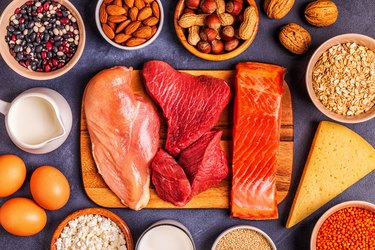
Beef, chicken, fish and eggs are all rich in protein, but the way you cook them affects their composition. Choosing the right cooking method can help you minimize nutrient loss and reduce the amount of harmful chemicals you get from eating meat.
Beef, Chicken and Other Meats
Video of the Day
Meats, such as beef and chicken, are a great addition to your diet as they contain protein and other key nutrients. For example, one beef patty with a quarter pound of ground beef has nearly 22 grams of protein. A 4-ounce skinless chicken breast boasts 23 grams of protein.
Video of the Day
Studies on the effects of cooking on meat have not shown significant changes in protein value, according to the American Meat Science Association. That being said, cooking meat at high temperatures for long periods of time can affect the structure of meat proteins.
When exposed to heat, meat proteins may become denatured, according to a November 2016 study in Comprehensive Reviews in Food Science and Food Safety. Denaturation causes proteins to break down into amino acids, which are still absorbed by the body and considered nutritionally beneficial, according to Elmhurst College.
Heating meat to too high temperatures, though, may affect the nutritional composition of the meat in other ways. For example, toxic chemicals, like advanced glycation end products (AGEs), can form when using methods of cooking that reach over 300 degrees Fahrenheit, according to the National Institutes of Health (NIH). These are linked to a higher risk of disease.
And, certain cooking methods may result in more nutrient loss than others. Boiling chicken and other meats at a temperature of 212 degrees or higher may cause them to lose valuable B vitamins, per December 2018 research in the Journal of Food Engineering.
Fish
Fish reacts similarly to beef and chicken when cooked at high temperatures. Fish protein can become oxidized when exposed to high temperatures, causing toxic byproducts to form, according to a May 2017 study in RSC Advances.
Specifically, the study showed that roasting and frying fish resulted in more protein oxidation than other cooking methods. The researchers recommend steaming fish at a maximum temperature of 212 degrees.
Cooking fish fast at high temperatures, such as with frying, may also result in a loss of healthy omega-3 fats, according to April 2014 research in Food Chemistry.
Beans and Eggs
Beans must be cooked before you eat them, even though they do lose some protein in the process, according to a February 2017 study in the International Journal of Food Science. Despite the loss, they're still a good source of protein, fiber and minerals.
Eggs, on the other hand, are not that sensitive to the effects of cooking. Cooking eggs may actually increase protein digestibility, according to a March 2018 study in the Journal of Food Science.
Tip
To maximize their health benefits, stick to black beans, lentils, garbanzo beans and kidney beans instead of refried beans, which are often loaded with saturated fats. When you buy canned beans, opt for low-sodium brands with no added sugar. Check the labels to get a clear picture of the ingredients used.
Why You Should Always Cook Meat and Fish
This doesn't mean you should eat your meat undercooked, though. To avoid food poisoning, the USDA recommends that beef be cooked to a minimum internal temperature of 145 degrees Fahrenheit, while ground beef should be cooked until it reaches 160 degrees.
Chicken should reach a temperature of 165 degrees to ensure that it's free of bacteria and other pathogens that may cause foodborne illnesses. Fish is safe to eat when it's been cooked to an internal temp of 145 degrees.
The Best Way to Cook Meat and Fish
The negative effects of cooking on nutrients in meat and fish can be minimized by choosing the right cooking method. A slow cooker set at low heat for a longer time keeps these foods in the optimal range for safety without going above the 212-degree (boiling) mark. Poaching and stewing are other optimal cooking methods for meat and fish.
Fish, in particular, can also be steamed or microwaved for nutrient retention and fewer harmful byproducts, per March 2010 research in the Journal of Food Science and Technology.
On the other hand, take caution when frying, grilling or broiling your meat and fish. Grilling temperatures easily reach 375 degrees Fahrenheit and broiling temperatures get as high as 500 degrees. Boiling meat or fish is also not ideal because it causes a loss of nutrients.
- USDA: Ground Beef Patty Cooked
- USDA: Boneless Skinless Chicken Breast
- Comprehensive Reviews in Food Science and Food Safety: "Cooking‐Induced Protein Modifications in Meat"
- USDA: "Safe Minimum Internal Temperature Chart"
- RSC Advances: "Proteomic Study of The Effect of Different Cooking Methods On Protein Oxidation in Fish Fillets"
- Food and Drug Administration: "Fish and Fishery Products Hazards and Controls Guidance"
- International Journal of Food Science: "Protein and Metalloprotein Distribution in Different Varieties of Beans (Phaseolus vulgaris L.): Effects of Cooking"
- Journal of Food Science: " Effect of Different Heat Treatments on In Vitro Digestion of Egg White Proteins and Identification of Bioactive Peptides in Digested Products"
- USDA: USDA Table of Nutrient Retention Factors
- Elmhurst College: Denaturation of Proteins
- NIH: Chemicals in Meat Cooked at High Temperatures and Cancer Risk
- Food Chemistry: Effect of different cooking methods on minerals, vitamins and nutritional quality indices of kutum roach (Rutilus frisii kutum)
- Journal of Food Science and Technology:Effect of different types of heat processing on chemical changes in tuna
- Journal of Food Science and Technology: Effect of different types of heat processing on chemical changes in tuna
- Journal of Food Engineering: Predicting the loss of vitamins B3 (niacin) and B6 (pyridoxamine) in beef during cooking